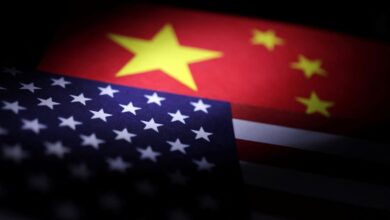Where ‘Made in China 2025’ missed the mark

China’s ambitious plan to achieve technological self-sufficiency, known as “Made in China 2025,” has faced setbacks and criticism, according to a recent report by the European Chamber of Commerce in China. The plan, launched in 2015, aimed to boost domestic tech development and reduce reliance on foreign technology. However, the country has fallen short of several key targets outlined in the plan, leading to concerns about unhealthy industrial competition and global trade tensions.
Despite exceeding targets in sectors like autos, China has not yet achieved dominance in aerospace, high-end robots, and manufacturing value-added growth. The European Chamber of Commerce highlighted that China’s self-developed airplane, the C919, still relies heavily on foreign parts, and industrial automation advancements are primarily driven by foreign technology. The growth rate of manufacturing value-added has also fallen short of the target, raising questions about the effectiveness of the ambitious plan.
However, despite these challenges, China has made significant progress in transforming its manufacturing industry. The country now accounts for 29% of global manufacturing value-added, almost equal to the combined contributions of the U.S. and Europe. This transformation has made China a direct competitor in various sectors where it previously lagged behind.
The U.S. has imposed restrictions on China’s access to high-end technology, pushing Chinese companies to develop homegrown alternatives. This shift has forced companies like Huawei to innovate and invest heavily in research and development. Huawei, for instance, reported a 22% revenue increase in 2024, driven by growth in its consumer products business. The company’s investment in R&D far exceeds its annual goal, signaling a commitment to technological advancement.
Despite these advancements, concerns remain about overcapacity and security issues in China’s tech sector. The electric car market, in particular, has seen a price war among automakers, leading to losses and inefficiencies. The phenomenon of “neijuan” or “involution” has emerged as companies compete to undercut each other, raising questions about the sustainability of such practices.
In conclusion, China’s journey towards technological self-sufficiency has been marked by both achievements and challenges. While the country has made significant strides in certain sectors, it still faces hurdles in achieving dominance across all targeted areas. As China continues to navigate these complexities, the global tech landscape is likely to see further shifts and developments in the coming years. Despite the efforts made by China to boost its manufacturing sector and move up the value chain, many industries are still struggling to see positive results. The “Made in China 2025” initiative, which aimed to increase the production of high-end equipment, has not translated into healthy business across the board.
According to a recent government work report delivered by Chinese Premier Li Qiang, there is a growing concern about involution in the country. Involution refers to the phenomenon where competition becomes so fierce that it hinders economic growth rather than promoting it. This issue was also highlighted in a directive from a high-level Politburo meeting last year.
The slowing economic growth in China is exacerbating the situation, with a significant number of mainland-listed companies reporting losses for the first time in 2024. In fact, nearly half of the companies analyzed reported losses, indicating the challenges faced by businesses in the current economic climate.
To address these issues, China has shifted its focus from manufacturing to boosting consumption. Retail sales growth has lagged behind industrial production, prompting policymakers to prioritize increasing domestic consumption. However, there is a need to ensure that manufacturing output aligns with market demand to avoid overcapacity.
As Eskelund pointed out, efforts to boost consumption will not be effective if manufacturing output continues to outpace market demand. Policymakers are now exploring ways to address manufacturing overcapacity and create a better balance between production and consumption.
In conclusion, while China’s efforts to upgrade its manufacturing sector have been ambitious, there are still challenges that need to be addressed. By tackling issues such as involution and overcapacity, China can work towards creating a more sustainable and balanced economy.





